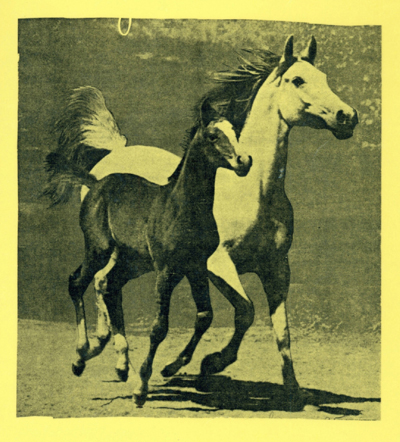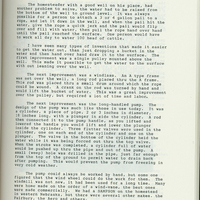037
Item
-
Title
-
037
-
Transcription
-
PUMPS AND WINDMILLS
The homesteader with a good well on his place, had another problem to solve, the water had to be raised from the bottom of the well to ground level. It was always possible for a person to attach a 3 or 4 gallon pail to a rope, and let it down in the well, and when the pail hit the water, give the rope a quick jerk and the pail would flip over and fill with water, then pull the rope hand over hand until the pail reached the surface. One person would have to work all day to water 100 head of cattle.
I have seen many types of inventions that made it easier to get the water out, than just dropping a bucket in the water and then hand over hand draw it to the surface. The first improvement was a single pulley mounted above the well. This made it possible to get the water to the surface with out leaning over the well.
The next improvement was a windlass. An A type frame was set over the well, a long rod placed thru the A frame. This rod was placed thru a small drum around which the rope could be wound. A crank on the rod was turned by hand and would lift the bucket of water. This was a great improvement over the pulley, but required a lot of time and labor.
The next improvement was the long-handled pump. The design of the pump was much like those in use today. It was a cylinder, a piece of pipe, 2 or 3 inches in diameter, 18 inches long, with a plunger in side the cylinder. A rod then connected it to the pump handle, as you lifted and lowered the handle you would lift and lower the plunger inside the cylinder. Three flutter valves were used in the cylinder, one on each end of the cylinder and one on the plunger. The valve in the bottom of the cylinder held the water while it was being forced out thru the top valve. When the stroke was completed, a cylinder full of water would be pushed up thru the pipe and out of the pump. A small (weep) hole was drilled in the pipe, just far enough from the top of the ground to permit water to drain back after pumping. This would prevent the pump from freezing in very cold weather.
The pump could always be worked by hand, but some one figured that the wind wheel could do the work for them. The windmill was not new, it had been used for a long time. Man were home made on the order of a wind-vane, the best ones were made commercially. We had a SAMPSON on the homestead in western Nebraska, but there were several other makes. [sic] the Fairbury, the Aero and others.
-
Rights
-
To inquire about usage, please contact Archives & Special Collections, University of Nebraska-Lincoln Libraries. These images are for educational use only. Not all images are available for publication.
 Metzger Memories
Metzger Memories


